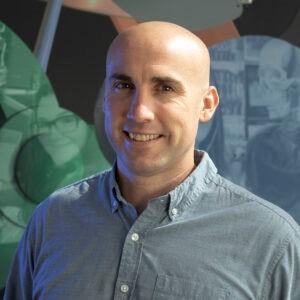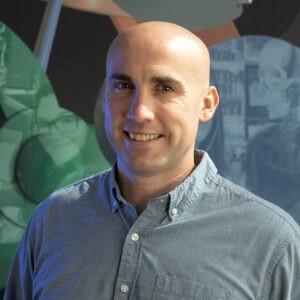Camden Rotarians explore options for students seeking skilled jobs
Should high school students aim for four years of college or take vocational training? It depends. But Mid-Coast School of Technology (MCST) Director Bobby Deetjen recently made the case to Camden Rotary Club that for many young people, training for skilled jobs through career technical education (CTE) offers is a terrific choice.
Deetjen explained that career tech ed saves students time and money by earning industry certifications that help them land skilled, well-paid jobs. It’s an increasingly popular option for students who seek a sustainable, satisfying way to live.
Programs at Rockland-based MCST include auto collision repair, auto technology, composites manufacturing, design/technology, English/technical communications, firefighting/EMT, health occupations, hospitality (culinary arts baking and pastry), machine tool, marine technology, mathematics, outdoor leadership, and pre-engineering.
In partnership with area secondary schools, MCST also runs a horticulture program on Islesboro and offers a CTE exploratory program at four regional high schools: Camden Hills, Medomak Valley, Oceanside, and Vinahaven. This project-based program allows students to explore a variety of subjects as they consider their career options.
“Students who participate in CTE directly apply what they’re learning in the classroom to attaining practical skills, and that possibility is attracting more and more people to this approach,” Deetjen said. “In some cases, getting into MCST is quite competitive. We have some programs that attract 30 to 40 applicants, but we can only accept 12. This is a challenge we need to work through, because we want every student to have an opportunity to come here.”
Deetjen observed that a significant nationwide skills gap is changing how people view CTE. That’s one reason it is the first choice for an increasing number of students. Unlike young people who go into debt to complete four years in college without knowing whether they will land a job afterward, CTE students tend to complete industry certifications and associate degrees with little or no debt and go straight to work.
“In manufacturing during the next seven years, the U.S. faces a shortage of 2.3 million skilled workers for well-paid jobs in manufacturing and many other trades,” Deetjen said. “Just this morning, we received a call from a local contractor asking for graduates. He knew he needed to call now because if he waited until June, all our construction graduates would already be snatched up. We receive these kinds of calls every day, not just from local employers but also nationally and throughout Maine. We’ve had businesses from as far away as Wisconsin asking for employees. And Bath Iron Works is looking to fill 2,700 spots by 2023 -- from basic welding and machining to carpentry.
Deetjen understands that bachelors’ and graduate degrees have significant value and often lead to lucrative careers. Still, he noted that in some states, it is no longer true that the higher a person’s degree, the higher their lifetime income will be.
“Texas, Colorado, and Alaska have all started to see an associate degree out-earn a bachelor’s degree,” Deetjen said. “The average student who goes through the University of Maine system will pay about $100,000 for their education and will leave school with about $25,000 in debt. If we look at the cost of an associate degree in, say, welding manufacturing, automotive collision, or carpentry, they’re going to pay about $22,000 for their education, including tuition, room, and board. Most of our students will have zero debt. And we’re seeing more and more jobs that require a certification and not necessarily a degree. From 1991 to 2016, we saw an 83 percent jump in STEM jobs that would pay $55,000 or more without a bachelor’s degree.”
Where do students go after they complete their studies at MCST?
- Many culinary students begin working in restaurants after graduating from MCST. Several have gone on to top cooking schools such as the Culinary Institute of America (CIA). One is now an up-and-coming executive chef.
- Students in the outdoor program go on to various careers – in the military, conservation law, professional guiding, adventure tourism, and other fields.
- Many MCST graduates choose public safety careers. One completed high school with 19 college credits, then dual-majored as a firefighter and paramedic at Southern Maine Community College. As part of her training, she was paid to go to school while working as a live-in firefighter. Today, she is a full-time paramedic and firefighter.
- Nursing students can become Certified Nursing Assistants (CNAs) at MCST, and many choose to take CNA jobs as they pursue degrees in nursing or other health occupations.
- Students can go from MCST’s auto collision program straight into jobs here and elsewhere. One graduate went on to Northern Maine Community College and double majored in structural welding and auto collision. She became the first female technician at a large auto collision center and now serves as their assistant manager. Free of student debt, she bought her first home at the age of 21.
- A machine tools student who built an electric engine from scratch at MCST went on to Wentworth Institute of Technology to study mechanical engineering and is now at the Colorado School of Mines to pursue research.
- Most years, about 25 to 30 percent of MCST students get jobs in the local area. Some of those who go on to either two- or four-year schools come back and work in the region. Deetjen said that a growing number of young adults and people raising families are moving back to the area or seeking it out as a beautiful place where they can enjoy a high quality of life.
Jonathan Goss, the lead organizer of the presentation series, thanked Deetjen for “bringing club members up to date on what’s happening locally in career technology education and how it benefits our regional and State work force development.”
Deetjen’s talk was the fourth in a monthly series aimed at helping Camden Rotarians learn about local economic challenges and foster potential solutions. Recordings of these talks are available via the club’s library of recorded presentations at www.camdenrotary.org. The next presentation in this series, on February 16, will focus on efforts to improve broadband internet access in the region.
The club welcomes visitors at its weekly meetings, which take place Tuesdays at noon on Zoom. Anyone who would like to attend can obtain connection details from Stephanie Griffin: steph.griffinsg00@gmail.com.
Joan Phaup is a member of the Camden Rotary Club
Event Date
Address
United States


























